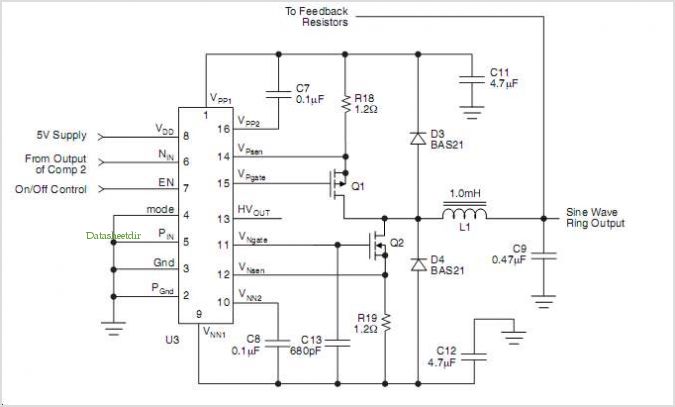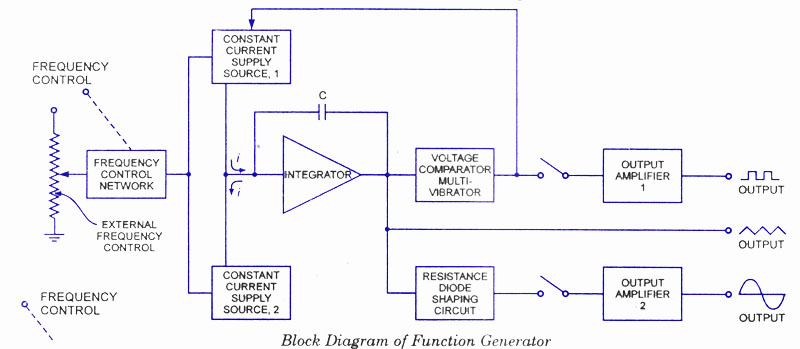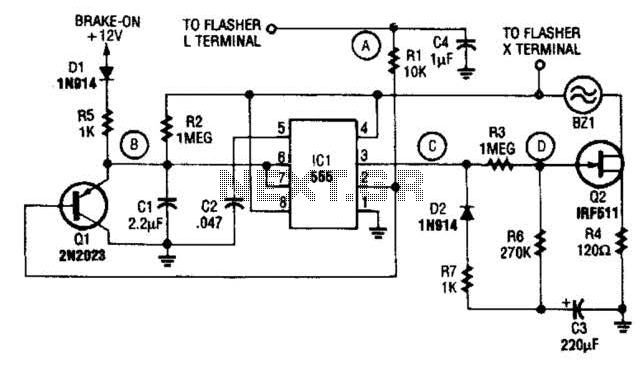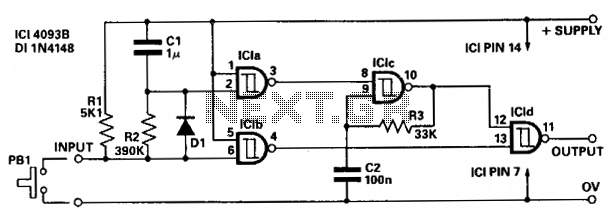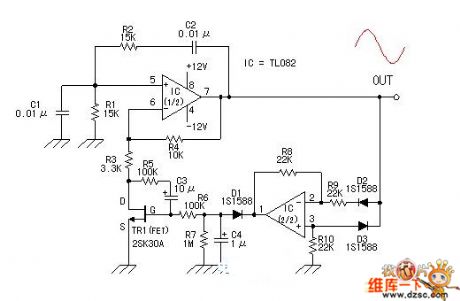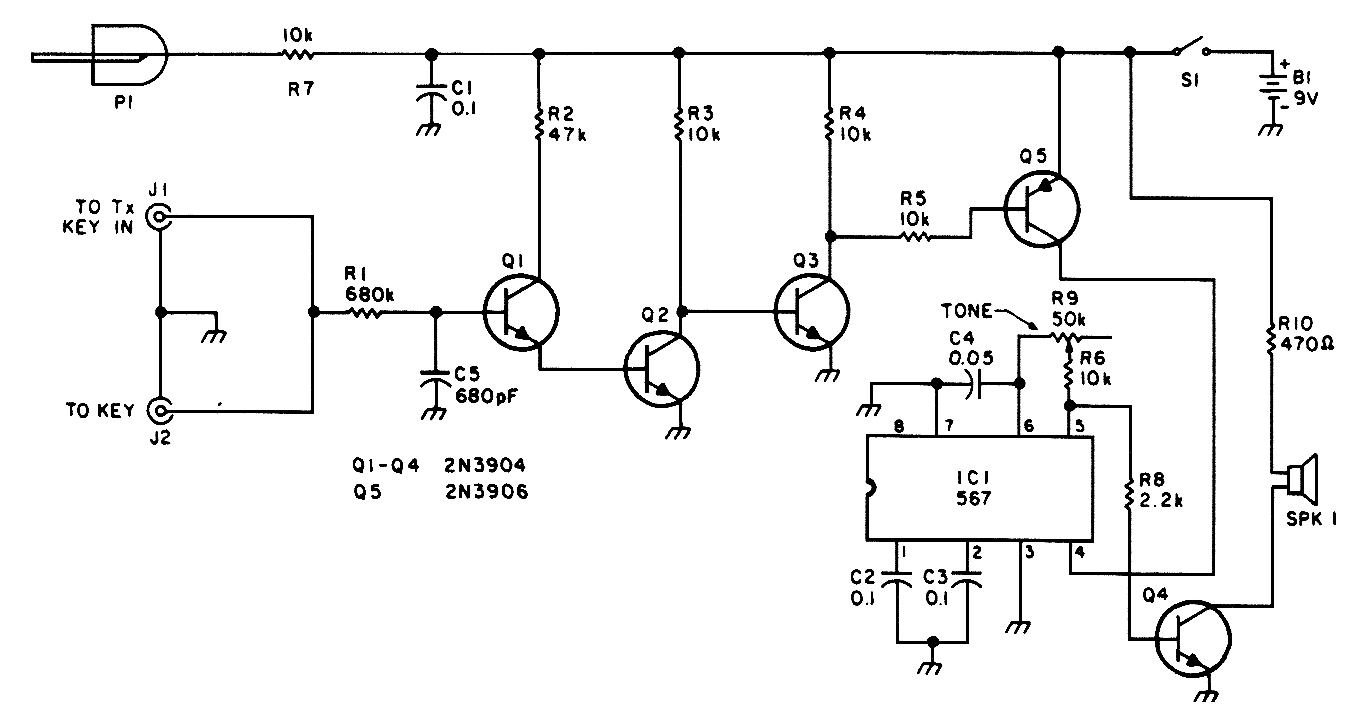
Pulse Signal Generator
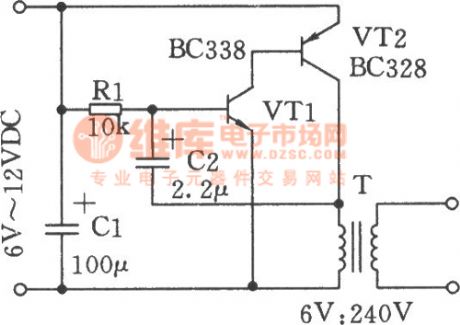
The volt-ampere characteristics of a tunnel diode exhibit an S-shaped curve. The peak current point, referred to as point P, represents the maximum current, while the valley point, denoted as point V, indicates the minimum current. Key parameters of the tunnel diode include: (1) Peak point voltage (Up) is approximately several tens of millivolts; valley point voltage (Uv) is around hundreds of millivolts. (2) Peak point current (Ipi) is in the range of several milliamperes, whereas valley point current (Iv) is about hundreds of microamperes. (3) The ratio of peak point current to valley point current is typically between 5 to 6, with a higher ratio being preferable. (4) Valley point capacitance (Cv) ranges from several microfarads to dozens of microfarads, with lower values being more desirable. An example is the 2BS4A diode manufactured in China, which has Up = 80 millivolts, Ip = 4 milliamperes, a valley point current ratio of ≥5, Cv = 10 to 15 microfarads, and Uv = 280 millivolts. The pulse and pulse train generator primarily consists of a CD4093 four two-input Schmitt trigger and a push-button switch. When the button is pressed, the circuit generates a single pulse; if pressed for an extended duration, it produces a pulse train. The circuit includes a push-button switch, input control circuit, pulse oscillator, and pulse output circuit. It operates on a 6V to 12V DC power supply to generate high-voltage pulses. The transistors VT1 and VT2 form an oscillator that generates a DC pulse voltage with a frequency of 3Hz, utilizing a primary coil of a booster transformer with a ratio of 6V to 240V. After each pulse, the secondary coil produces a high voltage. The pulse repetition frequency can be adjusted by modifying C2 and R1. For use in a baton, lead-acid batteries may be employed. The simple pulse signal generator circuit, constructed using a 74LS00, generates a 4 microsecond pulse signal with minimal components for ease of adjustment and maintenance. The logic pulse generator is capable of producing either positive or negative logic pulses as required. It comprises a four two-input NAND gate (CD4011), where gates D1 and D2 create an RS trigger pulse, and gates D3 and D4 function as inverters. The output from D1 is isolated and drives a light-emitting diode (LED) to indicate the logic state of the output pulse. The pulse frequency depends on the capacitance value, which can be set to 0.1uF or other appropriate values, with a 12KΩ resistor acting as the load resistor for the operational amplifier's open collector. In digital circuits, a pulse divider circuit is sometimes necessary to reduce the number of input pulses. The combination of CD4013 and feedback gates can create a pulse subtraction circuit, as illustrated in a countdown circuit composed of CD4013. Typically, when a pulse generator adjusts its oscillation frequency, the pulse width also changes. Conversely, if the pulse width needs adjustment, the oscillation frequency must be altered. A specific circuit allows for independent adjustment of pulse width and frequency. The PLL pulse generator circuit employs a phase-locked loop (PLL) to derive a fractional frequency from a crystal oscillator, producing a stepped frequency signal of 1kHz and pulse waveforms of 10kHz and 999kHz at the output terminal. The 74HC4060 integrated chip contains a NOT gate and a frequency divider circuit, with the NOT gate and a 4.096MHz crystal oscillator forming an oscillator circuit, while the frequency divider circuit generates a 1kHz reference frequency.Volt-ampere characteristics and parameter of tunnel diode Volt-ampere characteristics of tunnel diode (see picture a) is a S pattern curve. The highest current point P in the curve is called the peak; the lowest current point V is called valley point.
The main parameters of the tunnel diode are: (1) Peak point voltage Up is about dozens of millivolt; valley point voltage Uv is about hundreds of millivolt. (2) Peak point current Ipi is about several milliampere; valley point voltage Iv is about hundreds of microampere. (3) Proportion of peak point current and valley point current is about 5-6; the higher, the better. (4) Valley point capacitance Cv of from several microfarad to dozens of microfarad, and the lower, the better; 2BS4A made in China: Up=80 millivolt, Ip = 4 milliampere, valley point current proportion ‰¥5, Cv = 10 ½ 15 microfarad, Uv = 280 millivolt.
(View) Pulse and pulse train generator is mainly composed of a CD4093 four - two input terminals Schmitt trigger and a button switch. When people press the button, the circuit outputs a single pulse, when people press the button for a period of time, the circuit will output the pulse train.
The circuit is shown as the chart. The circuit consists of push button switch, input control circuit, pulse oscillator and pulse output circuit. (View) The circuit is shown as the chart, it uses the 6V ~ 12V DC power supply to produce high-voltage pulse.
In the circuit, the transistors VTl, VT2 constitute an oscillator to produce a DC pulse voltage with the frequency in 3Hz, and it has the primary coil of booster with the output transformer ratio in 6V: 240V, and after each pulse ends, the secondary coil of corresponding transformer will generate a high voltage level. Pulse repetition frequency can be selected by adjusting C2, Rl. When the circuit is used in the baton, it can use lead-acid batteries. (View) The Simple Pulse Signal Generator Circuit Composed Of 74LS00 is shown in the picture below. This Signal Generator uses mainly two TTL integrated circuit (74LS00) to generate t=4us pulse signal.
Its components used is just a few so that it is easy foradjustment andmaintenance. (View) Logic pulse generator can transport either positive or negtive logic pulse according to the need, the circuit is as shown. The circuit consists of a four - two input NAND gate CD4011, of which the door Dl, D2 form a RS trigger pulse, D3, D4 are used as inverters.
It isolates the output of D1 and then drives a light-emitting diode after reversing, it is used to indicate the logic state of the output pulse. (View) Pulse frequency depends on the size of the capacitance C, according to need can use 0. 1uF or other value. 12K © resistance is load resistor required by operational amplifier open collector. (View) In digital circuits, sometimes it needs pulse a divider circuit which could minus a few input pulse.
The appropriate combination ofCD4013 and feedback door can achieve any pulse subtraction circuit. Figure 3-1 shows 3-1 count down circuit composed of CD4013. (View) When general pulse generator adjust its oscillation frequency, the signal pulse width is also changed. Conversely, when it needs to change the pulse width, the oscillation frequency is changed. The circuit can make the pulse width and frequency be adjusted separately, they are independent from each other.
The circuit shows in Fig. (View) The PLL pulse generator is shown as the chart. The circuit is the phase-locked loop (PLL) pulse generator circuit. PLL makes a fractional frequency to crystal oscillator and gets 1kHz stepped frequency signal, moreover, it obtains 10kHz 999kHz pulse waveform on the output terminal. The manifold block 74HC4060 is a type of integrated chip with NOT gate and 1/2n frequency dividing circuit inside, among them, the NOT gate and the crystal oscillator with 4.
096MHz form a oscillator circuit, and the frequency dividing circuit gets lkHz reference f 🔗 External reference
The main parameters of the tunnel diode are: (1) Peak point voltage Up is about dozens of millivolt; valley point voltage Uv is about hundreds of millivolt. (2) Peak point current Ipi is about several milliampere; valley point voltage Iv is about hundreds of microampere. (3) Proportion of peak point current and valley point current is about 5-6; the higher, the better. (4) Valley point capacitance Cv of from several microfarad to dozens of microfarad, and the lower, the better; 2BS4A made in China: Up=80 millivolt, Ip = 4 milliampere, valley point current proportion ‰¥5, Cv = 10 ½ 15 microfarad, Uv = 280 millivolt.
(View) Pulse and pulse train generator is mainly composed of a CD4093 four - two input terminals Schmitt trigger and a button switch. When people press the button, the circuit outputs a single pulse, when people press the button for a period of time, the circuit will output the pulse train.
The circuit is shown as the chart. The circuit consists of push button switch, input control circuit, pulse oscillator and pulse output circuit. (View) The circuit is shown as the chart, it uses the 6V ~ 12V DC power supply to produce high-voltage pulse.
In the circuit, the transistors VTl, VT2 constitute an oscillator to produce a DC pulse voltage with the frequency in 3Hz, and it has the primary coil of booster with the output transformer ratio in 6V: 240V, and after each pulse ends, the secondary coil of corresponding transformer will generate a high voltage level. Pulse repetition frequency can be selected by adjusting C2, Rl. When the circuit is used in the baton, it can use lead-acid batteries. (View) The Simple Pulse Signal Generator Circuit Composed Of 74LS00 is shown in the picture below. This Signal Generator uses mainly two TTL integrated circuit (74LS00) to generate t=4us pulse signal.
Its components used is just a few so that it is easy foradjustment andmaintenance. (View) Logic pulse generator can transport either positive or negtive logic pulse according to the need, the circuit is as shown. The circuit consists of a four - two input NAND gate CD4011, of which the door Dl, D2 form a RS trigger pulse, D3, D4 are used as inverters.
It isolates the output of D1 and then drives a light-emitting diode after reversing, it is used to indicate the logic state of the output pulse. (View) Pulse frequency depends on the size of the capacitance C, according to need can use 0. 1uF or other value. 12K © resistance is load resistor required by operational amplifier open collector. (View) In digital circuits, sometimes it needs pulse a divider circuit which could minus a few input pulse.
The appropriate combination ofCD4013 and feedback door can achieve any pulse subtraction circuit. Figure 3-1 shows 3-1 count down circuit composed of CD4013. (View) When general pulse generator adjust its oscillation frequency, the signal pulse width is also changed. Conversely, when it needs to change the pulse width, the oscillation frequency is changed. The circuit can make the pulse width and frequency be adjusted separately, they are independent from each other.
The circuit shows in Fig. (View) The PLL pulse generator is shown as the chart. The circuit is the phase-locked loop (PLL) pulse generator circuit. PLL makes a fractional frequency to crystal oscillator and gets 1kHz stepped frequency signal, moreover, it obtains 10kHz 999kHz pulse waveform on the output terminal. The manifold block 74HC4060 is a type of integrated chip with NOT gate and 1/2n frequency dividing circuit inside, among them, the NOT gate and the crystal oscillator with 4.
096MHz form a oscillator circuit, and the frequency dividing circuit gets lkHz reference f 🔗 External reference
